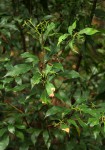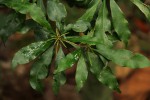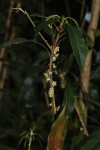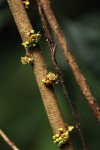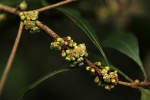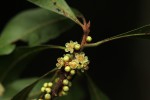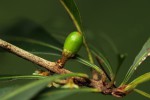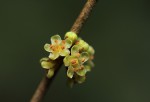Synsepalum chimanimani
All images: Click on each image to see a larger version and details of the record View selected images
Detailed records: Display species records QDS maps by: Google Maps Point records by Google Maps
Species details: Click on each item to see an explanation of that item (Note: opens a new window)
| Synonyms: |
Afrosersalisia kaessneri sensu Kupicha in Flora Zambesiaca 7(1): 217 (1983), pro parte Synsepalum kaessneri sensu Pennington in Gen. Sapotac.: 249 (1991), pro parte Synsepalum muelleri sensu Burrows et al. in Trees & Shrubs Mozambique: 744 (2018), pro parte Synsepalum sp. aff. S. kaessneri sensu Timberlake et Al. in CEPF Grant 63512 report: 50 (2016) Tulestea kaessneri sensu Aubréville in Adansonia Sér. 2, 12(2): 191–192 (1972), pro parte |
| Common names: | Chimanimani miraculous-berry (English) |
| Frequency: | |
| Status: | Native |
| Description: |
Shrub or small tree, up to 4 m tall. Bark brown, finely fissured; young branches, reddish-brown, velvety, typically zigzagging; milky latex present. Leaves crowded near the ends of branches, often clustered on small knobbly spurs, narrowly oblong-elliptic or oblanceolate, up to 12 × 3.5 cm, hairless; midrib prominent on both surfaces but veining indistinct; margin entire, wavy. Flowers solitary or in small clusters, axillary and on the older wood, small, whitish. Fruit solitary, ellipsoid, 1-1.5 cm long, pointed, fleshy, red, held in the enlarged, woody calyx. |
| Type location: |
Mozambique |
| Notes: | Note that the same images were used in Mozambique trees and shrubs (Burrows et Al., 2018: 744) as Synsepalum muelleri, to which taxon the populations from the Chimanimani foothills were previously believed to belong. S. muelleri, however is now considered to be restricted to northern Mozambique and southern Malawi. |
| Derivation of specific name: | chimanimani: referring to the Chimanimani Mts of Zimbabwe and Mozambique where the species is found. |
| Habitat: | In moist evergreen forest. |
| Altitude range: (metres) | 300 - 560 m |
| Flowering time: | Sep - Nov |
| Worldwide distribution: | Only known from the foot hills of the Chimanimani Mts in Mozambique and Zimbabwe. |
| FZ divisions: | MS |
| Growth form(s): | |
| Endemic status: | Near Endemic |
| Red data list status: | Endangered |
| Insects associated with this species: | |
| Spot characters: | Display spot characters for this species |
| Images last updated: | Tuesday 22 October 2019 |
| Literature: |
Burrows, J.E., Burrows, S.M., Lötter, M.C. & Schmidt, E. (2018). Trees and Shrubs Mozambique Publishing Print Matters (Pty), Cape Town. Page 744. As Synsepalum muelleri (Includes a picture). Darbyshire, I., Timberlake, J., Osborne, J., Rokni, S., Matimele, H., Langa. C., Datizua, C., de Sousa, C., Alves, T., Massingue, A., Hadj-Hammou, J., Dhanda, S., Shah, T., Wursten, B. (2019). The endemic plants of Mozambique: diversity and conservation status Phytotaxa 136 Page 94. Drummond, R.B. (1975). A list of trees, shrubs and woody climbers indigenous or naturalised in Rhodesia. Kirkia 10(1) Page 266. As Tulestea kassneri Golding, J.S. (ed.) (2002). Zimbabwe Plant Red Data List. Southern African Plant Red Data Lists. SABONET 14 Page 169. As Synsepalum keassneri Kupicha, F.K. (1983). Sapotaceae Flora Zambesiaca 7(1) Page 217. As Afrosersalisia kassneri Mapaura, A. & Timberlake, J. (eds) (2004). A checklist of Zimbabwean vascular plants Southern African Botanical Diversity Network Report No. 33 Sabonet, Pretoria and Harare Page 77. As Synsepalum keassneri Rokni, S., Wursten, B. & Darbyshire, I. (2019). Synsepalum chimanimani (Sapotaceae), a new species from the Chimanimani Mountains of Mozambique and Zimbabwe, with notes on the botanical importance of this area Phytokeys 133 Pages 117 - 122. Protologue (Includes a picture). Timberlake, J., Darbyshire, I., Wursten, B., Hadj-Hammou, J., Ballings, P., Mapaura, A., Matimele, H., Banze, A., Chipanga, H., Muassinar, D., Massunde, J., Chelene, I., Osborne, J., Shah, T. (2016). Chimanimani Mountains: Botany and Conservation. Report produced under CEPF Grant 63512. Royal Botanic Gardens, Kew, London. Page 50. As Synsepalum sp. aff. S. kassneri (Engl.) T.D. Penn. |
Other sources of information about Synsepalum chimanimani:
Our websites:
Flora of Zimbabwe: Synsepalum chimanimaniExternal websites:
African Plants: A Photo Guide (Senckenberg): Synsepalum chimanimaniAfrican Plant Database: Synsepalum chimanimani
BHL (Biodiversity Heritage Library): Synsepalum chimanimani
EOL (Encyclopedia of Life): Synsepalum chimanimani
GBIF (Global Biodiversity Information Facility): Synsepalum chimanimani
Google: Web - Images - Scholar
iNaturalist: Synsepalum chimanimani
IPNI (International Plant Names Index): Synsepalum chimanimani
JSTOR Plant Science: Synsepalum chimanimani
Mansfeld World Database of Agricultural and Horticultural Crops: Synsepalum chimanimani
Plants of the World Online: Synsepalum chimanimani
Tropicos: Synsepalum chimanimani
Wikipedia: Synsepalum chimanimani

